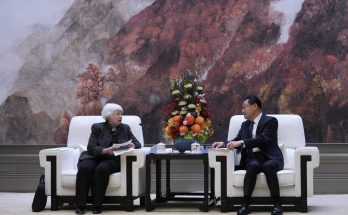 The term ‘miracle’ recurs as a leitmotif in any discussion on China’s much-touted economic growth rates. Behind this miracle lies massive investments by the Chinese state. Foreign Direct Investments (FDI) are an additional yet enormous factor behind the miracle.
The term ‘miracle’ recurs as a leitmotif in any discussion on China’s much-touted economic growth rates. Behind this miracle lies massive investments by the Chinese state. Foreign Direct Investments (FDI) are an additional yet enormous factor behind the miracle.
In trying to understand how investments could lay the foundations of future growth, a case study of the Tibet Autonomous Region becomes pertinent. Tibet, which is still one of the poorest provinces in the country, massively lacks infrastructural bases for industrial growth to take off. Tibet’s case stands out even more when compared with the southern and eastern provinces of China. However, given the “new normal” under which the country is currently operating, which means slower growth rates from the medium to long term, provinces which have traditionally not been the best performers in terms of contribution to China’s Gross Domestic Product (GDP), are now being focussed upon by the state.
As per statistics released by the Chinese government in April, the Chinese economy grew at an annual rate of 6.7 per cent in the first quarter of 2016. It is the slowest quarterly growth in the Chinese economy in seven years, but is in line with expectations and China’s own growth targets. In the list of provinces that recorded highest quarterly growth rates, Tibet and Chongqing rank first with 10.7 per cent each, followed by Guizhou. Beijing ranks at 23 with 6.9 per cent, while Shanghai ranks 25 with 6.7 per cent. The highest growth rates have been recorded in provinces which have traditionally been the poorest provinces with the least rates of urbanisation and capital formation, and hence have low GDP base. Tibet’s GDP ranks the last in China, and has 590,000 rural residents living under the poverty line of 2,300 Yuan in annual income1.
Focus Areas: Drivers of growth
 The main cause for the increasing economic growth rate in Tibet is heavy domestic investment in traditional industries such as mining and metals, and new industries such as hydro and solar power. Massive investments are also being made into transport and tourism infrastructures, and in funding, new rail lines and airports. As per a report in Bloomberg, since 1951, the Central government has spent more than 648 billion Yuan in the region. Beijing’s subsidies have funded massive transportation and power projects, including a 156-mile-long rail link from Tibet’s capital, Lhasa, to Shigatse, the region’s second-largest city, which was completed at a cost of 13.3 billion Yuan. The 9.6 billion-Yuan Zangmu hydropower station on the Yarlung Tsangpo River has been made fully operational. Following the opening of the Golmud-Lhasa railway line in 2006, there has been a massive boom in mining operations on the Tibetan plateau.
The main cause for the increasing economic growth rate in Tibet is heavy domestic investment in traditional industries such as mining and metals, and new industries such as hydro and solar power. Massive investments are also being made into transport and tourism infrastructures, and in funding, new rail lines and airports. As per a report in Bloomberg, since 1951, the Central government has spent more than 648 billion Yuan in the region. Beijing’s subsidies have funded massive transportation and power projects, including a 156-mile-long rail link from Tibet’s capital, Lhasa, to Shigatse, the region’s second-largest city, which was completed at a cost of 13.3 billion Yuan. The 9.6 billion-Yuan Zangmu hydropower station on the Yarlung Tsangpo River has been made fully operational. Following the opening of the Golmud-Lhasa railway line in 2006, there has been a massive boom in mining operations on the Tibetan plateau.
These mega projects are part of the state’s heavy investments in the region. According to the Tibetan government work report of 2014, investment from the central government, state-owned enterprises and the private sector reached 35.3 billion Yuan, 10 billion Yuan and 30 billion Yuan, respectively. The combination of the three accounted for 81 percent of Tibet’s 2014 GDP2. Investment from the central government thus remains the highest.
According to a circular issued by the Chinese Central Bank in March 2016, Beijing will continue to roll out preferential financial policies to boost economic and social development in Tibet over the next five years and monetary and credit policy support will be fine-tuned during the 2016-2020 period. The circular adds that financial institutions will be encouraged to open branches in Tibet and more direct financing and financial bonds are expected to help enterprises in Tibet, especially small and micro businesses.
Big Plans
Some of the plans for Tibet in 2016 include building a second railway connecting Tibet with other parts of the country. The railway will be built between Lhasa and Chengdu. According to reports, the new railway will be about 1,629 km long, and it will only take 15 hours for trains travelling between Lhasa and Chengdu. An investment of 3.6 million Yuan has been made for infrastructure construction and basic operations on the Qinghai-Tibet highway. As per the plans, investments will be made in service stations along the highway, which will offer waste recycling, toilets, hot water, Wi-Fi access and power outlets. Additionally, 490 million Yuan will be spent over the next five years on the repair and protection of sites for the traditional Tibetan funeral practice of sky burial, as stated by local authorities in Tibet in March this year.
 Beyond these, the State Forestry Administration agreed to provide financial and promotional support for four new wetland parks in Tibet in March this year. With more than 6.5 million hectares of wetland, Tibet has more than 5 per cent of China’s total wetlands, and establishing more wetland parks will help in protection of water resources and biodiversity.
Beyond these, the State Forestry Administration agreed to provide financial and promotional support for four new wetland parks in Tibet in March this year. With more than 6.5 million hectares of wetland, Tibet has more than 5 per cent of China’s total wetlands, and establishing more wetland parks will help in protection of water resources and biodiversity.
With the development of drinking water businesses in Tibet, the enterprises have become a significant contributor to the region’s economic growth, tax base and employment. With an investment from Sinopec in Tibet in 2014, Tibet Glacial Water was rapidly and widely spread around most of China’s big cities. More of such enterprises will be set up. While investing in Tibet is meant to ensure that the region becomes more economically developed and the huge gap in economic performance between Tibet on the one hand and the other provinces on the other can be closed; it is also a way to address the overall slowing growth rate in China.
The Way Ahead: A Cautionary Note
 Due to wage increases in the coastal provinces, which have been the drivers of the export-led growth mechanism in the country, profits are now shrinking for domestic as well as foreign enterprises and several enterprises have relocated to inland provinces or to other countries, which have a cost advantage over China. It is clear from the investments in Tibet that a clear resort to Keynesian economics is being undertaken to boost growth in China. However, one side effect of Beijing’s subsidise-and-invest policy is that Tibet is afflicted by a version of the profligacy that led to China’s own slowdown in the first phase.
Due to wage increases in the coastal provinces, which have been the drivers of the export-led growth mechanism in the country, profits are now shrinking for domestic as well as foreign enterprises and several enterprises have relocated to inland provinces or to other countries, which have a cost advantage over China. It is clear from the investments in Tibet that a clear resort to Keynesian economics is being undertaken to boost growth in China. However, one side effect of Beijing’s subsidise-and-invest policy is that Tibet is afflicted by a version of the profligacy that led to China’s own slowdown in the first phase.
The region is plagued by inefficient and money-losing state-owned enterprises. As of 2013, they accounted for about 22 percent of all companies in Tibet, compared with 2 percent in all of China, according to a recent research paper written by Jin Wei, an expert on China’s ethnic minority policy at the Central Party School in Beijing. In order to ensure that Tibet does turn out to be a pole of growth for the country, it has to be certified that the export dependence that China created for itself in the past does not become the story for Tibet as well.
(The author is a Consultant at the Policy Planning and Research Division of the Ministry of External Affairs. The views expressed are personal and do not reflect those of the MEA or of the Government of India)
Author Profile
- India Writes Network (www.indiawrites.org) is an emerging think tank and a media-publishing company focused on international affairs & the India Story. Centre for Global India Insights is the research arm of India Writes Network. To subscribe to India and the World, write to editor@indiawrites.org. A venture of TGII Media Private Limited, a leading media, publishing and consultancy company, IWN has carved a niche for balanced and exhaustive reporting and analysis of international affairs. Eminent personalities, politicians, diplomats, authors, strategy gurus and news-makers have contributed to India Writes Network, as also “India and the World,” a magazine focused on global affairs.
Latest entries
 In ConversationJuly 26, 2024India-Italy defence collaboration can extend to third countries: Anil Wadhwa
In ConversationJuly 26, 2024India-Italy defence collaboration can extend to third countries: Anil Wadhwa In ConversationJuly 23, 2024Italy views India as a key partner in Indo-Pacific: Vani Rao
In ConversationJuly 23, 2024Italy views India as a key partner in Indo-Pacific: Vani Rao DiplomacyJune 29, 2024First BRICS unveils a roadmap for boosting tourism among emerging economies
DiplomacyJune 29, 2024First BRICS unveils a roadmap for boosting tourism among emerging economies India and the WorldJune 11, 2024On Day 1, Jaishankar focuses on resolving standoff with China
India and the WorldJune 11, 2024On Day 1, Jaishankar focuses on resolving standoff with China






